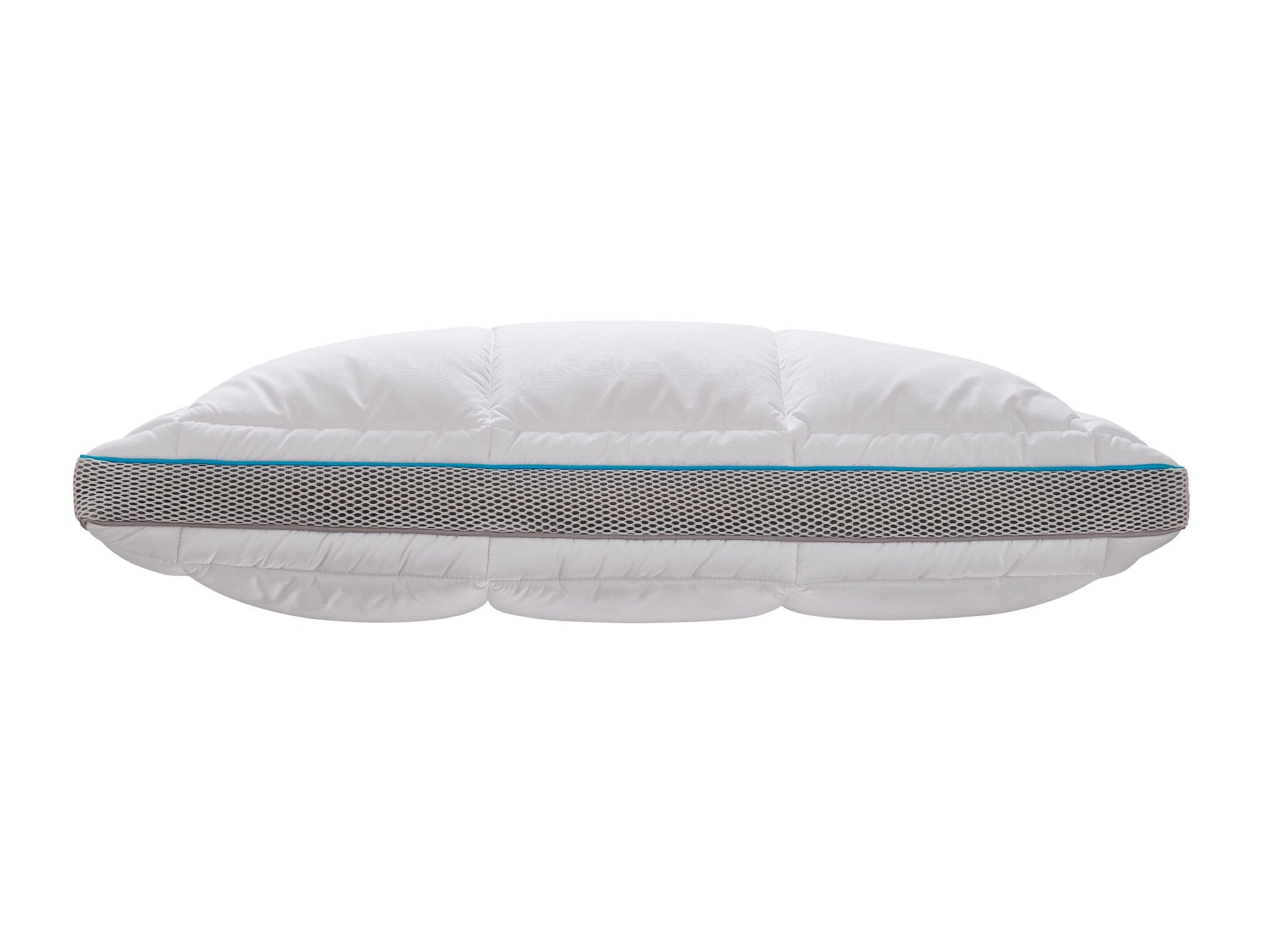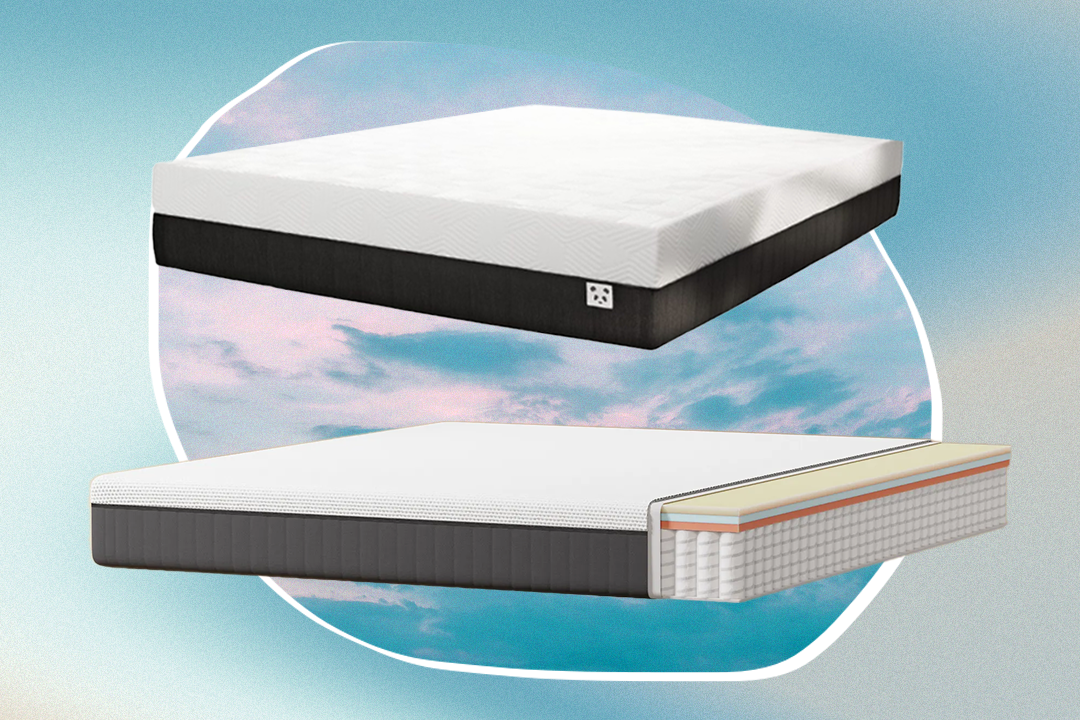Simba hybrid pillow

- Dimensions: 45cm x 70cm, 60cm x 60cm
- Filling: Nanocube core
- Cover: Cotton
- Why we love it
- Endlessly adaptable
- Synthetic fill makes this pillow ideal for anyone who suffers from allergies
- Plenty of support
Firmness
Simba says the pillow is filled with “nanocubes” and uses “nanocube technology” to give you the perfect night’s sleep. But what does that mean? Unlike older pillows that use memory foam (usually made from a polymer known as polyurethane), Simba’s nanocubes are made from open-cell foam made up of lots of tiny sealed cells filled with air. They compress and bounce back with real spring, which makes the pillow feel more like a traditional feather or down fill, and less like you’re sleeping on a wedge of plastic.
In terms of firmness, it feels somewhere between a feather pillow and a memory foam pillow: the closest comparison we found was with a natural fibre like wool. There is plenty of support, particularly if you retain all the nanocubes and fluff them up occasionally, and your head doesn’t sink all the way to the mattress the same way it would with a down fill. But there is always a degree of give, which is particularly nice if you sleep on a firmer mattress and on your side (so you have a very low pillow).
Comfort
Sure, this pillow doesn’t have the sumptuous, hotel-style plumpness of a fully-lofted down pillow. But it also won’t give you chronic neck ache. The nanocube fill is a triumph: it is really comfortable and squishy. But where this pillow also shines is its climate control. Its two sides are made from different materials, and the turquoise-bordered side uses a technology Simba calls “stratos”. Microcapsules applied to the cover absorb, store and release body heat depending on how warm or cold you get.
The other side, with a silver border, is made from ethically sourced, breathable cotton. You can spot the difference between the two surfaces, but with a pillowcase on, you won’t feel any difference in texture. Our reviewers naturally gravitated to the climate-controlled blue side and never had an uncomfortable night’s sleep.
The thick mesh stripe that runs around the middle of the pillow keeps air circulating around the cubes, which contributes to the coolness.
Sleeping position
The amount of lift you get from this pillow is entirely customisable because you can move the cubes – or they seem to naturally drift – to where you most need them. You can even remove whole handfuls. So when Simba says this pillow is for every sleeping style, they’re not exaggerating.
Our reviewer, a side-front sleeper, moved most of the nanocubes from the base of the pillow to the top to give her a wedge-shaped pillow with a low profile at the neck. Front sleepers might like to remove some of the nanocubes to drop the height even more, while back sleepers can retain all the nanocubes, and might like to open the pillow and move them around every week or so to keep maximum loft all over.
Adjusting the cubes is really simple: unzip the outer cover, then the inner cover, reach in and mess them up.
Allergies
The synthetic fill makes this pillow ideal for anyone who suffers from allergies and can’t sleep on a natural or traditional fill. The microfibre layer that sits between the cubes and the cover is also hypoallergenic, and the cover is really easy to take off and wash.
Eco-friendliness
Old-fashioned memory foam is shockingly bad for the environment, so it’s good to see that Simba is trying to innovate in this area as well. The foam used to make the nanocubes is produced without TCPP and other chemicals – including phosphate, parabens, biocides and persistent organic pollutants – while remaining fire-safe. As well as being better for the environment, this makes the foam easier to recycle.
Care
You can wash the cover but not the fill – the nanocubes, with their little air cells, would probably never recover from the shock. Because the quilting on the cover is comfortable and the cover itself is so easy to wash (in a machine up to 40 degrees C) we didn’t find we needed a pillow protector.
After almost a year of relentless side-sleeping and occasionally working from bed, we did find that some of the nanocubes in our test pillow lost their bounce. This was easy to fix by opening up the fill compartment and moving them around a little: it’s worth doing this every couple of weeks, or whenever you notice the pillow has lost its height.
Price
Costing more than £100, this is one of the pricier synthetic pillows on the market. But it doesn’t go near the dizzying cost of some high-end down pillows, which can easily cost upwards of £200. Given that the pillow gives you the benefits of a down pillow – loft and comfort – and the practicalities of a foam pillow, we think it’s reasonably priced.
It’s also endlessly adaptable: if you buy it when you’re pregnant and sleeping on your back, for example, you can adjust the fill later to suit it to side sleeping. If you’re injured and want a supportive pillow to aid recovery, you can buy it for that, then refill it with nanocubes when you’re back-to-back sleeping.




